-
 1601 A Tudor Fireside Conversation As Written by the Ingenuous, Virtuous and learned Mark Twain, wit., Embellished by the worthy Alan Odle, Mark Twain, illustrations Alan Odle (Land's End Press, USA, 1969, stated "At London, Printed for Subscribers Only and are to be sold at ye beare Back-Side in Maiden Lane") 8.75"x11.25", 24pp (unpaginated), hardbound with mylar-protected dust jacket, red boards with gilt titles [Date: 1601.] Conversation, as it was the Social Fireside, in the Time of the Tudors is the title of a humorous work by Mark Twain, first published anonymously in 1880. Edward Wagenknecht once referred to it as "the most famous piece of pornography in American literature." Its content is irreverent and vulgar rather than obscene, and its purpose seems to be comedic shock rather than erotic arousal. It would thus qualify as ribaldry rather than pornography. Twain wrote 1601 during the summer of 1876 (between writing Tom Sawyer and Huckleberry Finn), for the amusement of his closest friend, Reverend Joseph Twichell, 1601 was later first published by another friend, John Hay, who later became Secretary of State. The work circulated among printers (due to it's often archaic type font) and many small batches were printed, however the authorship of the work remained unverified until Twain finally acknowledged he wrote it in 1906.
1601 A Tudor Fireside Conversation As Written by the Ingenuous, Virtuous and learned Mark Twain, wit., Embellished by the worthy Alan Odle, Mark Twain, illustrations Alan Odle (Land's End Press, USA, 1969, stated "At London, Printed for Subscribers Only and are to be sold at ye beare Back-Side in Maiden Lane") 8.75"x11.25", 24pp (unpaginated), hardbound with mylar-protected dust jacket, red boards with gilt titles [Date: 1601.] Conversation, as it was the Social Fireside, in the Time of the Tudors is the title of a humorous work by Mark Twain, first published anonymously in 1880. Edward Wagenknecht once referred to it as "the most famous piece of pornography in American literature." Its content is irreverent and vulgar rather than obscene, and its purpose seems to be comedic shock rather than erotic arousal. It would thus qualify as ribaldry rather than pornography. Twain wrote 1601 during the summer of 1876 (between writing Tom Sawyer and Huckleberry Finn), for the amusement of his closest friend, Reverend Joseph Twichell, 1601 was later first published by another friend, John Hay, who later became Secretary of State. The work circulated among printers (due to it's often archaic type font) and many small batches were printed, however the authorship of the work remained unverified until Twain finally acknowledged he wrote it in 1906. -
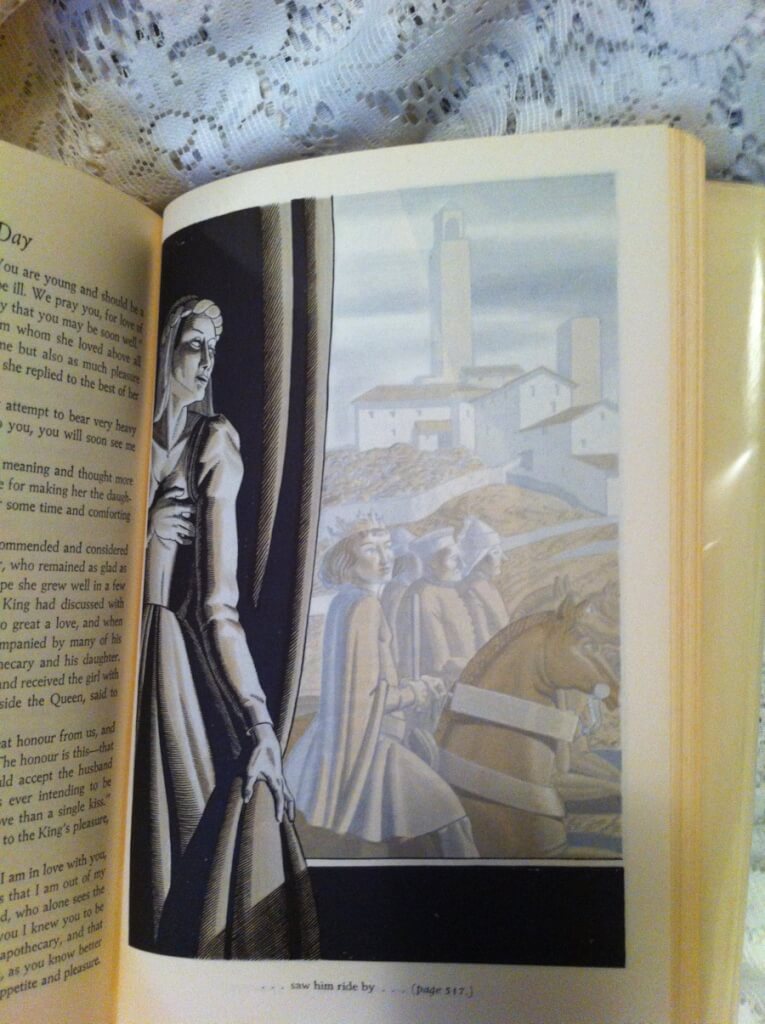
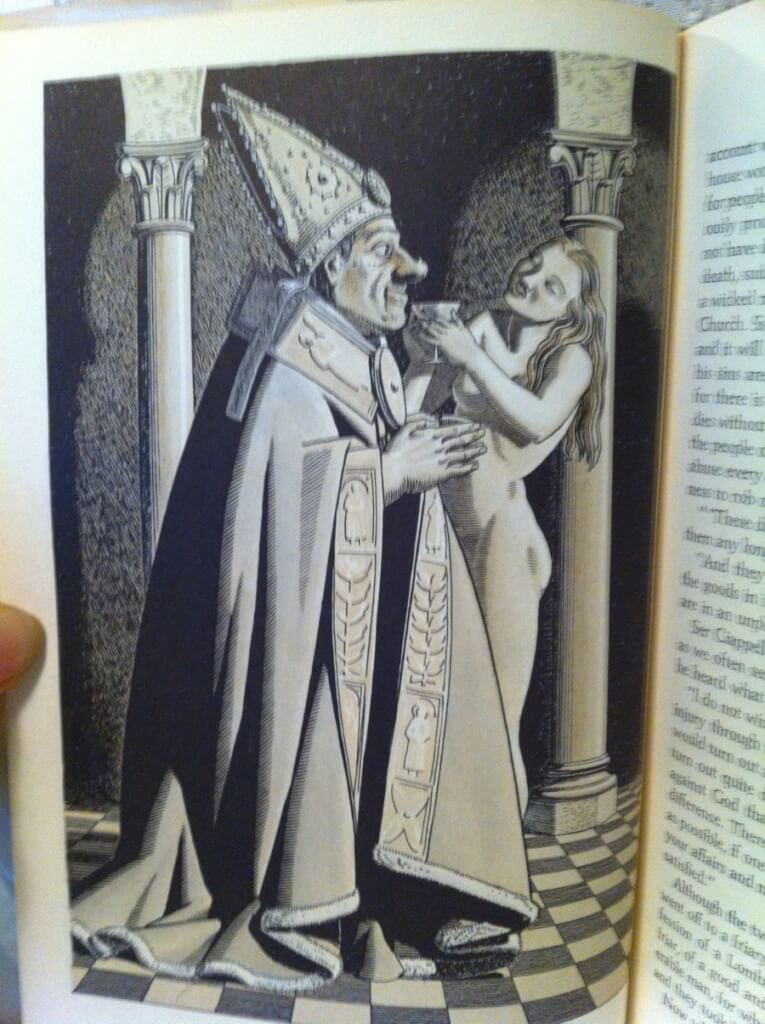 The Decameron of Giovanni Boccaccio, Giovanni Boccaccio, trans. Richard Aldington, illustrated by Rockwell Kent (Garden City Books, Garden City, NY, 1949 [date of illustrations]) 9 1/2" X 6 3/8", 562pp, hardbound with DJ protected by mylar, green boards with cream spine, great condition. This is the popular (at the time) Garden City edition. Superb art deco color illustrations throughout by Rockwell Kent (famous illustrator of Moby Dick and others). The Decameron, (subtitled Prencipe Galeotto or Prince Galehaut), is a collection of novellas by the 14th-century Italian author Giovanni Boccaccio (1313–1375). The book is structured as a frame story containing 100 tales told by a group of seven young women and three young men sheltering in a secluded villa just outside Florence to escape the Black Death, which was afflicting the city. To make their exile more pleasant each of the ten tells the others one story every day. The Decameron records the narratives of ten days -- 100 stories. Boccaccio probably conceived of The Decameron after the epidemic of 1348, and completed it by 1353. These tales run the entire range of human emotion: grief, love, humor, anger, revenge. Many are based on oral folklore. Boccaccio's ten narrators thus retell already familiar stories about errant priests, rascally husbands, and mischievous wives. Variants of these stories are known in many cultures, but no one formulates them more cleverly or relates them more eloquently than does Boccaccio. In addition to its literary value and widespread influence, it provides a document of life at the time. Written in the vernacular of the Florentine language, it is considered a masterpiece of classical early Italian prose.
The Decameron of Giovanni Boccaccio, Giovanni Boccaccio, trans. Richard Aldington, illustrated by Rockwell Kent (Garden City Books, Garden City, NY, 1949 [date of illustrations]) 9 1/2" X 6 3/8", 562pp, hardbound with DJ protected by mylar, green boards with cream spine, great condition. This is the popular (at the time) Garden City edition. Superb art deco color illustrations throughout by Rockwell Kent (famous illustrator of Moby Dick and others). The Decameron, (subtitled Prencipe Galeotto or Prince Galehaut), is a collection of novellas by the 14th-century Italian author Giovanni Boccaccio (1313–1375). The book is structured as a frame story containing 100 tales told by a group of seven young women and three young men sheltering in a secluded villa just outside Florence to escape the Black Death, which was afflicting the city. To make their exile more pleasant each of the ten tells the others one story every day. The Decameron records the narratives of ten days -- 100 stories. Boccaccio probably conceived of The Decameron after the epidemic of 1348, and completed it by 1353. These tales run the entire range of human emotion: grief, love, humor, anger, revenge. Many are based on oral folklore. Boccaccio's ten narrators thus retell already familiar stories about errant priests, rascally husbands, and mischievous wives. Variants of these stories are known in many cultures, but no one formulates them more cleverly or relates them more eloquently than does Boccaccio. In addition to its literary value and widespread influence, it provides a document of life at the time. Written in the vernacular of the Florentine language, it is considered a masterpiece of classical early Italian prose. -
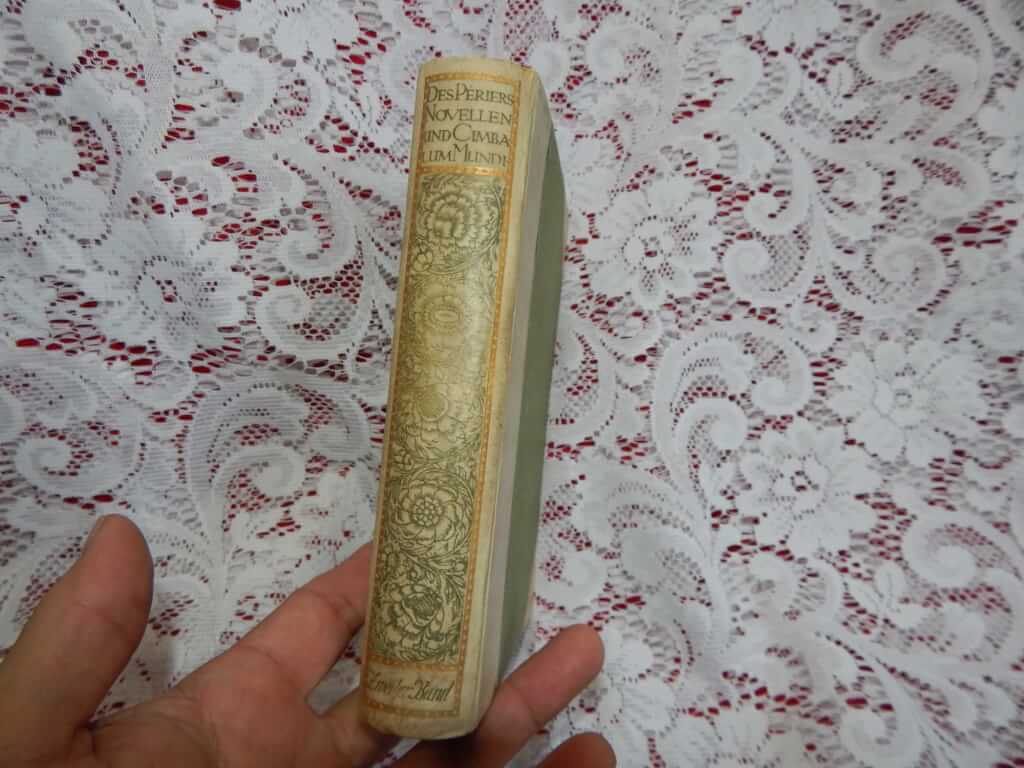
 Novellen und Cymbalum Mundi: Die neuen Schwänke und lustigen Unterhaltungen gefolgt von der Weltbimmel (VOL 2 only), by Bonaventure Des Periers. "For the first time translated from French and introduced by Hanns Floerke with 10 illustrations by Franz von Bayros" (Georg Müller, München und Leipzig 1910) 5.25"x7", 404pp, vol 2 of 2, top edge gilt, other edges deckled, 3/4 vellum on green boards, 5 illustrations by Bayros tipped in, ribbon present but detached, good+ condition. German translation of Des Periers short stories and Cymbalum Mundi, Four Very Ancient Joyous and Facetious Dialogues. Bonaventure des Périers (c. 1500 – 1544) was a French storyteller and humanist who attained notoriety as a freethinker. Margaret of Angoulême, queen of Navarre, made him her valet de chambre in 1536. He acted as her secretary and transcribed her Heptaméron; some maintain that he in fact wrote the work. The free discussions permitted at Margaret’s court encouraged a license of thought as displeasing to the Calvinists as to the Roman Catholics; it became skepticism in Des Périers’s Cymbalum Mundi, a brilliant and violent attack upon Christianity. The allegorical form of its four dialogues in imitation of the Greek rhetorician Lucian did not conceal its real meaning. It was suppressed (c. 1538), but it was reprinted in Paris in the same year. His book made many bitter enemies for Des Périers, who prudently left Paris and settled at Lyon. Tradition has it that he killed himself in 1544, but this is questionable. Franz von Bayros (1866–1924) was an Austrian commercial artist, illustrator, and painter, best known for his controversial Tales at the Dressing Table portfolio, a book considered so dangerous to the morality of the time that Von Bayros was arrested and forced into exile. He was obliged to move from one European capital to another as each outrageous new work was banned by the authorities.
Novellen und Cymbalum Mundi: Die neuen Schwänke und lustigen Unterhaltungen gefolgt von der Weltbimmel (VOL 2 only), by Bonaventure Des Periers. "For the first time translated from French and introduced by Hanns Floerke with 10 illustrations by Franz von Bayros" (Georg Müller, München und Leipzig 1910) 5.25"x7", 404pp, vol 2 of 2, top edge gilt, other edges deckled, 3/4 vellum on green boards, 5 illustrations by Bayros tipped in, ribbon present but detached, good+ condition. German translation of Des Periers short stories and Cymbalum Mundi, Four Very Ancient Joyous and Facetious Dialogues. Bonaventure des Périers (c. 1500 – 1544) was a French storyteller and humanist who attained notoriety as a freethinker. Margaret of Angoulême, queen of Navarre, made him her valet de chambre in 1536. He acted as her secretary and transcribed her Heptaméron; some maintain that he in fact wrote the work. The free discussions permitted at Margaret’s court encouraged a license of thought as displeasing to the Calvinists as to the Roman Catholics; it became skepticism in Des Périers’s Cymbalum Mundi, a brilliant and violent attack upon Christianity. The allegorical form of its four dialogues in imitation of the Greek rhetorician Lucian did not conceal its real meaning. It was suppressed (c. 1538), but it was reprinted in Paris in the same year. His book made many bitter enemies for Des Périers, who prudently left Paris and settled at Lyon. Tradition has it that he killed himself in 1544, but this is questionable. Franz von Bayros (1866–1924) was an Austrian commercial artist, illustrator, and painter, best known for his controversial Tales at the Dressing Table portfolio, a book considered so dangerous to the morality of the time that Von Bayros was arrested and forced into exile. He was obliged to move from one European capital to another as each outrageous new work was banned by the authorities. -
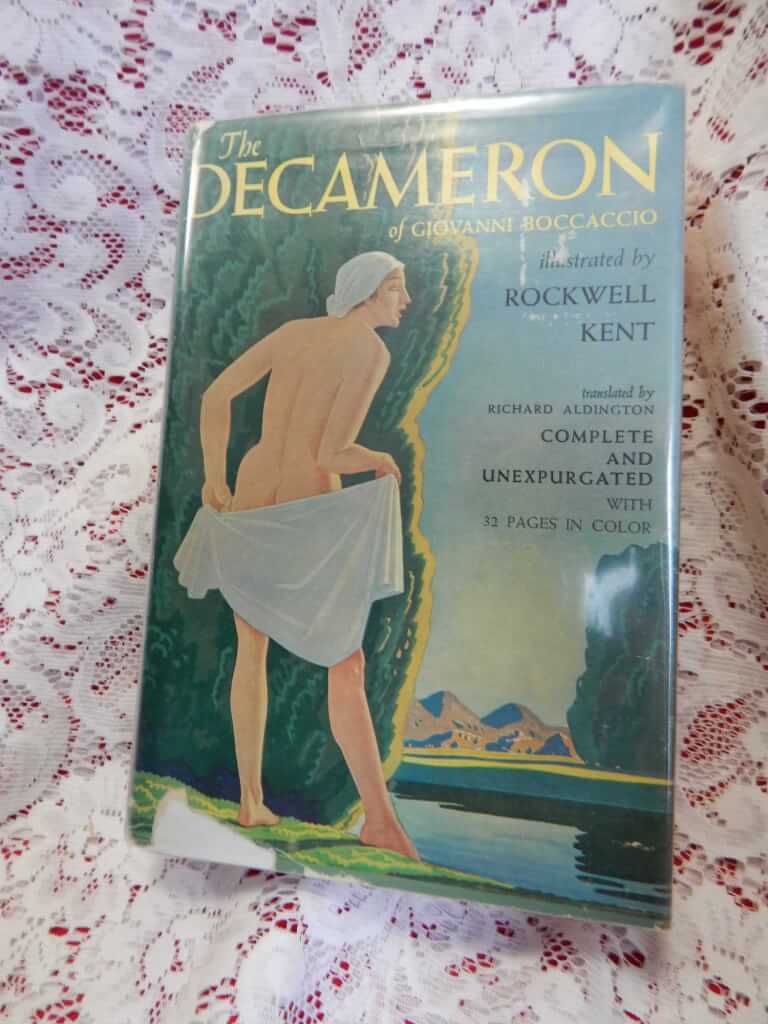
 The Decameron of Giovanni Boccaccio, Giovanni Boccaccio, trans. Richard Aldington, illustrated by Rockwell Kent (Garden City Books, Garden City, NY, 1949 [date of illustrations]) 9 1/2" X 6 3/8", 562pp, hardbound with DJ (with some rips) protected by mylar, green boards with cream spine, great condition. This is the popular (at the time) Garden City edition. Superb art deco color illustrations throughout by Rockwell Kent (famous illustrator of Moby Dick and others). The Decameron, (subtitled Prencipe Galeotto or Prince Galehaut), is a collection of novellas by the 14th-century Italian author Giovanni Boccaccio (1313–1375). The book is structured as a frame story containing 100 tales told by a group of seven young women and three young men sheltering in a secluded villa just outside Florence to escape the Black Death, which was afflicting the city. To make their exile more pleasant each of the ten tells the others one story every day. The Decameron records the narratives of ten days -- 100 stories. Boccaccio probably conceived of The Decameron after the epidemic of 1348, and completed it by 1353. These tales run the entire range of human emotion: grief, love, humor, anger, revenge. Many are based on oral folklore. Boccaccio's ten narrators thus retell already familiar stories about errant priests, rascally husbands, and mischievous wives. Variants of these stories are known in many cultures, but no one formulates them more cleverly or relates them more eloquently than does Boccaccio. In addition to its literary value and widespread influence, it provides a document of life at the time. Written in the vernacular of the Florentine language, it is considered a masterpiece of classical early Italian prose.
The Decameron of Giovanni Boccaccio, Giovanni Boccaccio, trans. Richard Aldington, illustrated by Rockwell Kent (Garden City Books, Garden City, NY, 1949 [date of illustrations]) 9 1/2" X 6 3/8", 562pp, hardbound with DJ (with some rips) protected by mylar, green boards with cream spine, great condition. This is the popular (at the time) Garden City edition. Superb art deco color illustrations throughout by Rockwell Kent (famous illustrator of Moby Dick and others). The Decameron, (subtitled Prencipe Galeotto or Prince Galehaut), is a collection of novellas by the 14th-century Italian author Giovanni Boccaccio (1313–1375). The book is structured as a frame story containing 100 tales told by a group of seven young women and three young men sheltering in a secluded villa just outside Florence to escape the Black Death, which was afflicting the city. To make their exile more pleasant each of the ten tells the others one story every day. The Decameron records the narratives of ten days -- 100 stories. Boccaccio probably conceived of The Decameron after the epidemic of 1348, and completed it by 1353. These tales run the entire range of human emotion: grief, love, humor, anger, revenge. Many are based on oral folklore. Boccaccio's ten narrators thus retell already familiar stories about errant priests, rascally husbands, and mischievous wives. Variants of these stories are known in many cultures, but no one formulates them more cleverly or relates them more eloquently than does Boccaccio. In addition to its literary value and widespread influence, it provides a document of life at the time. Written in the vernacular of the Florentine language, it is considered a masterpiece of classical early Italian prose. -
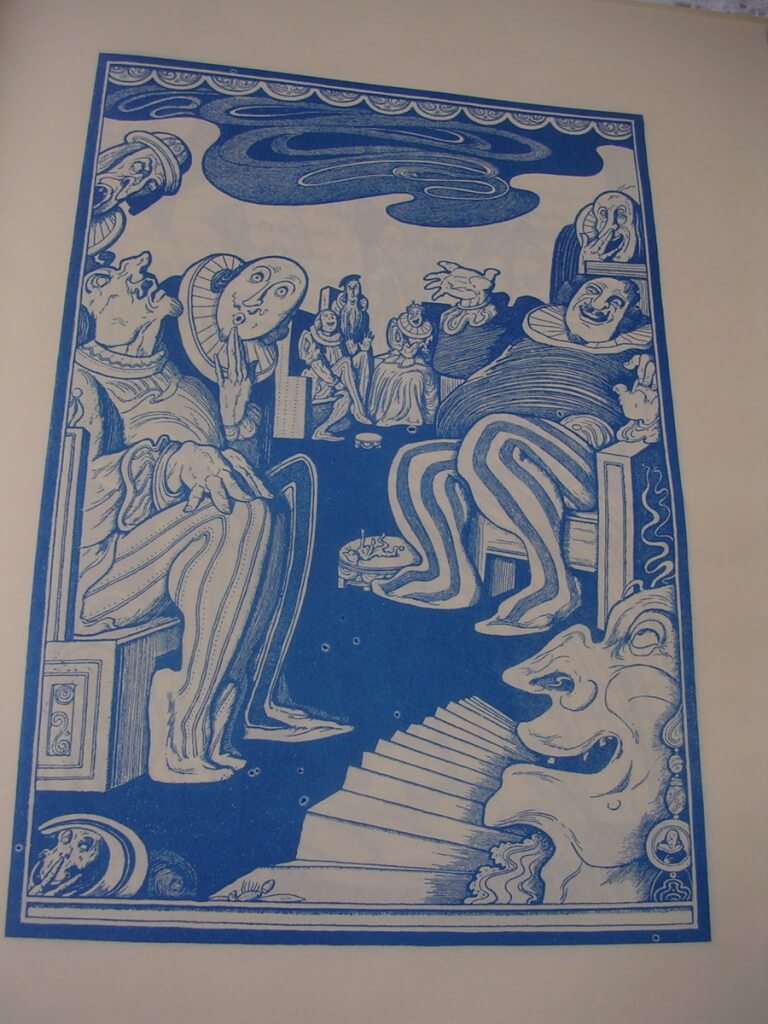
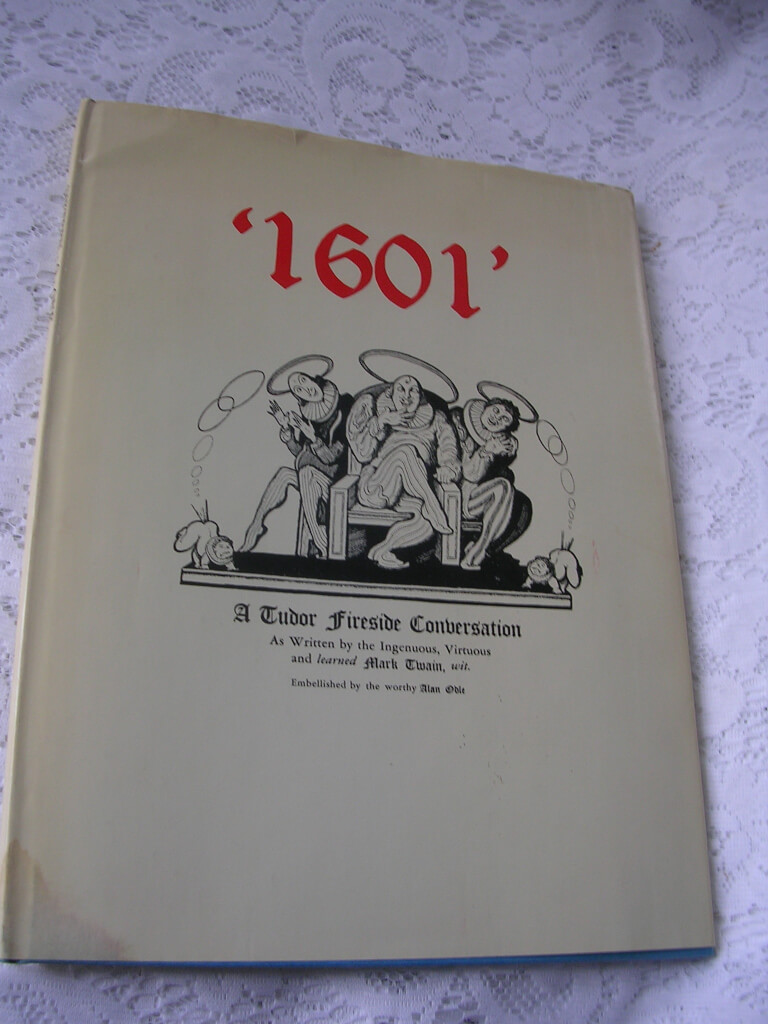 1601 A Tudor Fireside Conversation As Written by the Ingenuous, Virtuous and learned Mark Twain, wit., Embellished by the worthy Alan Odle, Mark Twain, illustrations Alan Odle (Land's End Press, USA, 1969, stated "At London, Printed for Subscribers Only and are to be sold at ye beare Back-Side in Maiden Lane") 12 1/2" X 9 1/2", 24pp (unpaginated), hardbound with dust jacket, blue boards with blue titles, pages, pages printed in such a way that the lower edge is uncut (six folded sheets of paper printed on one side, making up 4 pages) [Date: 1601.] Conversation, as it was the Social Fireside, in the Time of the Tudors is the title of a humorous work by Mark Twain, first published anonymously in 1880. Edward Wagenknecht once referred to it as "the most famous piece of pornography in American literature." Its content is irreverent and vulgar rather than obscene, and its purpose seems to be comedic shock rather than erotic arousal. It would thus qualify as ribaldry rather than pornography. Twain wrote 1601 during the summer of 1876 (between writing Tom Sawyer and Huckleberry Finn), for the amusement of his closest friend, Reverend Joseph Twichell, 1601 was later first published by another friend, John Hay, who later became Secretary of State. The work circulated among printers (due to it's often archaic type font) and many small batches were printed, however the authorship of the work remained unverified until Twain finally acknowledged he wrote it in 1906.
1601 A Tudor Fireside Conversation As Written by the Ingenuous, Virtuous and learned Mark Twain, wit., Embellished by the worthy Alan Odle, Mark Twain, illustrations Alan Odle (Land's End Press, USA, 1969, stated "At London, Printed for Subscribers Only and are to be sold at ye beare Back-Side in Maiden Lane") 12 1/2" X 9 1/2", 24pp (unpaginated), hardbound with dust jacket, blue boards with blue titles, pages, pages printed in such a way that the lower edge is uncut (six folded sheets of paper printed on one side, making up 4 pages) [Date: 1601.] Conversation, as it was the Social Fireside, in the Time of the Tudors is the title of a humorous work by Mark Twain, first published anonymously in 1880. Edward Wagenknecht once referred to it as "the most famous piece of pornography in American literature." Its content is irreverent and vulgar rather than obscene, and its purpose seems to be comedic shock rather than erotic arousal. It would thus qualify as ribaldry rather than pornography. Twain wrote 1601 during the summer of 1876 (between writing Tom Sawyer and Huckleberry Finn), for the amusement of his closest friend, Reverend Joseph Twichell, 1601 was later first published by another friend, John Hay, who later became Secretary of State. The work circulated among printers (due to it's often archaic type font) and many small batches were printed, however the authorship of the work remained unverified until Twain finally acknowledged he wrote it in 1906. -
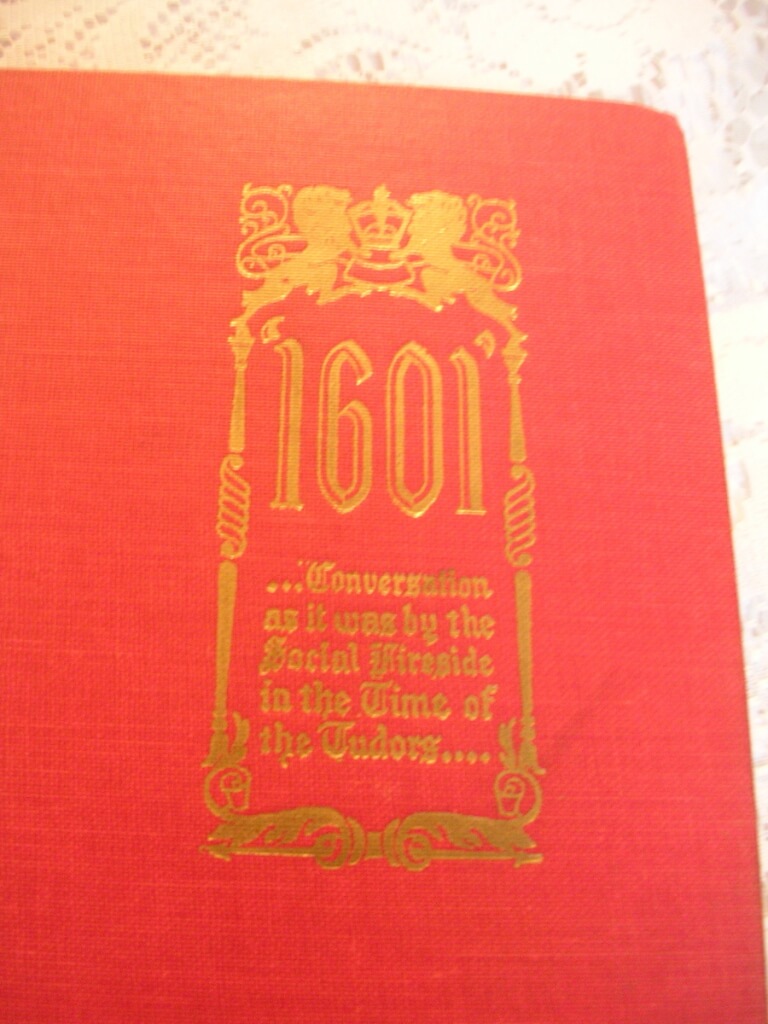
 Mark Twain's [Date, 1601.] Conversation As it was by the Social Fireside in the Time of the Tudors, Mark Twain, "With an Illuminating Introduction, Facetions Footnotes and a Bibliography by Franklin J. Meine" (Privately Printed for Lyle Stuart, New York, nd [c. 1939]) 9 1/2" X 6 1/4", 80pp, hardbound no DJ with slipcase, red cloth boards with gilt lettering and decoration, book very good condition, slight soiling on spine, slipcover good condition, faded spine and soiled but intact [Date: 1601.] Conversation, as it was the Social Fireside, in the Time of the Tudors is the title of a humorous work by Mark Twain, first published anonymously in 1880. Edward Wagenknecht once referred to it as "the most famous piece of pornography in American literature." Its content is irreverent and vulgar rather than obscene, and its purpose seems to be comedic shock rather than erotic arousal. It would thus qualify as ribaldry rather than pornography. Twain wrote 1601 during the summer of 1876 (between writing Tom Sawyer and Huckleberry Finn), for the amusement of his closest friend, Reverend Joseph Twichell, 1601 was later first published by another friend, John Hay, who later became Secretary of State. The work circulated among printers (due to it's often archaic type font) and many small batches were printed, however the authorship of the work remained unverified until Twain finally acknowledged he wrote it in 1906.
Mark Twain's [Date, 1601.] Conversation As it was by the Social Fireside in the Time of the Tudors, Mark Twain, "With an Illuminating Introduction, Facetions Footnotes and a Bibliography by Franklin J. Meine" (Privately Printed for Lyle Stuart, New York, nd [c. 1939]) 9 1/2" X 6 1/4", 80pp, hardbound no DJ with slipcase, red cloth boards with gilt lettering and decoration, book very good condition, slight soiling on spine, slipcover good condition, faded spine and soiled but intact [Date: 1601.] Conversation, as it was the Social Fireside, in the Time of the Tudors is the title of a humorous work by Mark Twain, first published anonymously in 1880. Edward Wagenknecht once referred to it as "the most famous piece of pornography in American literature." Its content is irreverent and vulgar rather than obscene, and its purpose seems to be comedic shock rather than erotic arousal. It would thus qualify as ribaldry rather than pornography. Twain wrote 1601 during the summer of 1876 (between writing Tom Sawyer and Huckleberry Finn), for the amusement of his closest friend, Reverend Joseph Twichell, 1601 was later first published by another friend, John Hay, who later became Secretary of State. The work circulated among printers (due to it's often archaic type font) and many small batches were printed, however the authorship of the work remained unverified until Twain finally acknowledged he wrote it in 1906. -
 The Golden Ass of Apuleius, Lucius Apuleius Madaurensis (124-170 AD), trans. & intro Francis D. Byrne (The Imperial Press[Charles Carrington?], London, n.d. [1904?]) 8.25" X 6.25", xlix+588pp., hardbound, blue cloth boards with paper label on spine, top edge gilt, other edges deckled, just good condition, tearing to top of spine, no illustrations present. The Metamorphoses of Apuleius, which St. Augustine referred to as “The Golden Ass”, is the only Ancient Roman novel in Latin to survive in its entirety. The plot Lucius and his curiosity and insatiable desire to see and practice magic. While trying to perform a spell to transform into a bird, he is accidentally transformed into an ass. This leads to a long journey, literal and metaphorical, filled with in-set tales. He finally finds salvation through the intervention of the goddess Isis, whose cult he joins. The date of the original work is uncertain. Scholars are not sure if he wrote it in his youth or at the end of his life. He adapted the story from a Greek story written by Lucius of Patrae, however his original Greek text has long been lost.
The Golden Ass of Apuleius, Lucius Apuleius Madaurensis (124-170 AD), trans. & intro Francis D. Byrne (The Imperial Press[Charles Carrington?], London, n.d. [1904?]) 8.25" X 6.25", xlix+588pp., hardbound, blue cloth boards with paper label on spine, top edge gilt, other edges deckled, just good condition, tearing to top of spine, no illustrations present. The Metamorphoses of Apuleius, which St. Augustine referred to as “The Golden Ass”, is the only Ancient Roman novel in Latin to survive in its entirety. The plot Lucius and his curiosity and insatiable desire to see and practice magic. While trying to perform a spell to transform into a bird, he is accidentally transformed into an ass. This leads to a long journey, literal and metaphorical, filled with in-set tales. He finally finds salvation through the intervention of the goddess Isis, whose cult he joins. The date of the original work is uncertain. Scholars are not sure if he wrote it in his youth or at the end of his life. He adapted the story from a Greek story written by Lucius of Patrae, however his original Greek text has long been lost. -
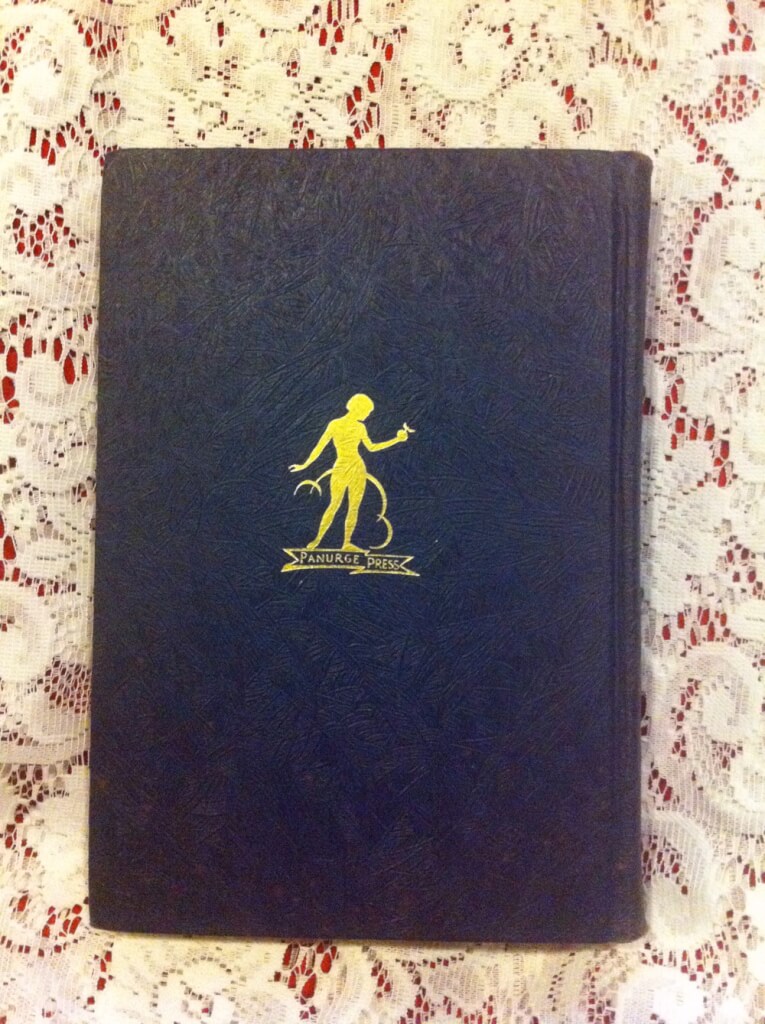
 The Heptameron, of Margaret, Queen of Navarre, Margaret of Navarre, Léopold Flameng illus. (Printed by Private Subscription and for private circulation only, np. nd. London, #61/500) 6.25″ X 7.5″, xxix-384pp, three-quarter bound over marbled boards, gilt title & decorations including boarder of leather, 8 etchings by Flameng The Heptameron is a collection of 72 short stories written in French by Marguerite of Navarre (1492-1549), published posthumously in 1558. It has the form of a frame narrative and was inspired by The Decameron of Giovanni Boccaccio. It was originally intended to contain one hundred stories covering ten days just as The Decameron does, but at Marguerite’s death it was only completed as far as the second story of the eighth day. Many of the stories deal with love, lust, infidelity, and other romantic and sexual matters. I do not know publisher or date to this edition, although it is very similar to the 1881 G. Barrie edition (page numbers and the Flemeng plates, and the Edition De Luxe label). Either it is a later pirate of that edition or an alternate printing from that batch.
The Heptameron, of Margaret, Queen of Navarre, Margaret of Navarre, Léopold Flameng illus. (Printed by Private Subscription and for private circulation only, np. nd. London, #61/500) 6.25″ X 7.5″, xxix-384pp, three-quarter bound over marbled boards, gilt title & decorations including boarder of leather, 8 etchings by Flameng The Heptameron is a collection of 72 short stories written in French by Marguerite of Navarre (1492-1549), published posthumously in 1558. It has the form of a frame narrative and was inspired by The Decameron of Giovanni Boccaccio. It was originally intended to contain one hundred stories covering ten days just as The Decameron does, but at Marguerite’s death it was only completed as far as the second story of the eighth day. Many of the stories deal with love, lust, infidelity, and other romantic and sexual matters. I do not know publisher or date to this edition, although it is very similar to the 1881 G. Barrie edition (page numbers and the Flemeng plates, and the Edition De Luxe label). Either it is a later pirate of that edition or an alternate printing from that batch. -

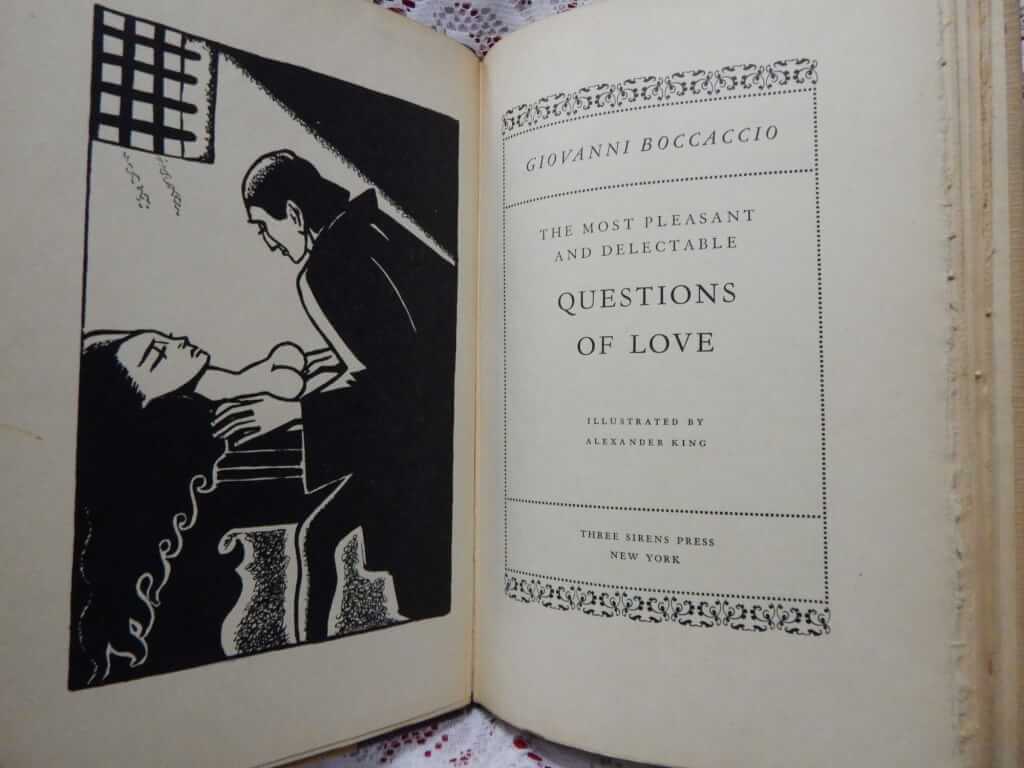 The Most Pleasant and Delectable Questions of Love, by Giovanni Boccaccio, illus. by Alexander King (Three Sirens Press, [copyright, Illustrated Editions Company, New York] 1931) 6.5"x9.5", 133pp, gilt top-edge other edges deckled, tan and maroon boards, binding good, some soiling and edges bumped. "The translation of 1566 [the fourth part of Filocolo] by H. G. Put into modern English with an introduction by Thomas Bell." This book is 13 chapters of one of Boccaccio's longer works, "Il libro di Difinizioni", first translated into English by "H.G." (probably Henry Grantham) in London, 1566. In these chapters, a group of young people have gone to the country for the day. One of the young women is chosen "The Queen of Love." Each young person tells a love story and poses a question about love. The group answers; there is no right or wrong. But the final arbiter, "The Queen of Love," holds the answers. Giovanni Boccaccio (1313-1375) was an Italian author and poet, a friend, student, and correspondent of Petrarch, an important Renaissance humanist and the author of a number of notable works including the Decameron, On Famous Women, and his poetry in the Italian vernacular. Boccaccio is particularly notable for his dialogue, of which it has been said that it surpasses in verisimilitude that of virtually all of his contemporaries, since they were medieval writers and often followed formulaic models for character and plot. Alexander King (1899–1965), born Alexander Koenig in Vienna, was a bestselling humorist, memoirist and media personality of the early television era, based in the United States. In his late fifties, after becoming a frequent guest on the a Tonight Show hosted by Jack Paar, King emerged as an incongruous presence in the realm of national celebrity: an aging, irascible raconteur, with elegant mannerisms and trademark bow-tie, who spoke frankly and disarmingly about his bohemian lifestyle, multiple marriages, and years-long struggle with drug addiction. His checkered past led TIME magazine to describe him as "an ex-illustrator, ex-cartoonist, ex-adman, ex-editor, ex-playwright, ex-dope addict. For a quarter-century he was an ex-painter, and by his own bizarre account qualifies as an ex-midwife. He is also an ex-husband to three wives and an ex-Viennese of sufficient age (60) to remember muttonchopped Emperor Franz Joseph. When doctors told him a few years ago that he might soon be an ex-patient (two strokes, serious kidney disease, peptic ulcer, high blood pressure), he sat down to tell gay stories of the life of all these earlier Kings."
The Most Pleasant and Delectable Questions of Love, by Giovanni Boccaccio, illus. by Alexander King (Three Sirens Press, [copyright, Illustrated Editions Company, New York] 1931) 6.5"x9.5", 133pp, gilt top-edge other edges deckled, tan and maroon boards, binding good, some soiling and edges bumped. "The translation of 1566 [the fourth part of Filocolo] by H. G. Put into modern English with an introduction by Thomas Bell." This book is 13 chapters of one of Boccaccio's longer works, "Il libro di Difinizioni", first translated into English by "H.G." (probably Henry Grantham) in London, 1566. In these chapters, a group of young people have gone to the country for the day. One of the young women is chosen "The Queen of Love." Each young person tells a love story and poses a question about love. The group answers; there is no right or wrong. But the final arbiter, "The Queen of Love," holds the answers. Giovanni Boccaccio (1313-1375) was an Italian author and poet, a friend, student, and correspondent of Petrarch, an important Renaissance humanist and the author of a number of notable works including the Decameron, On Famous Women, and his poetry in the Italian vernacular. Boccaccio is particularly notable for his dialogue, of which it has been said that it surpasses in verisimilitude that of virtually all of his contemporaries, since they were medieval writers and often followed formulaic models for character and plot. Alexander King (1899–1965), born Alexander Koenig in Vienna, was a bestselling humorist, memoirist and media personality of the early television era, based in the United States. In his late fifties, after becoming a frequent guest on the a Tonight Show hosted by Jack Paar, King emerged as an incongruous presence in the realm of national celebrity: an aging, irascible raconteur, with elegant mannerisms and trademark bow-tie, who spoke frankly and disarmingly about his bohemian lifestyle, multiple marriages, and years-long struggle with drug addiction. His checkered past led TIME magazine to describe him as "an ex-illustrator, ex-cartoonist, ex-adman, ex-editor, ex-playwright, ex-dope addict. For a quarter-century he was an ex-painter, and by his own bizarre account qualifies as an ex-midwife. He is also an ex-husband to three wives and an ex-Viennese of sufficient age (60) to remember muttonchopped Emperor Franz Joseph. When doctors told him a few years ago that he might soon be an ex-patient (two strokes, serious kidney disease, peptic ulcer, high blood pressure), he sat down to tell gay stories of the life of all these earlier Kings." -

 Das Dekameron, by Giovanni Baccaccio, illustrated by F. v. Bayros. With a foreword by Hanns Heinz Ewers (Wilhelm Borngräber Verlag, Berlin., 1913) 5.25"x7.5", 612pp + 4 pages of ads, hardcover, half buckram with gilt title and decorations, very good condition. German language of Boccaccio's Decameron with 6 illustrations by Franz von Bayros. The Decameron, (subtitled Prencipe Galeotto or Prince Galehaut), is a collection of novellas by the 14th-century Italian author Giovanni Boccaccio (1313–1375). The book is structured as a frame story containing 100 tales told by a group of seven young women and three young men sheltering in a secluded villa just outside Florence to escape the Black Death, which was afflicting the city. To make their exile more pleasant each of the ten tells the others one story every day. The Decameron records the narratives of ten days -- 100 stories. Boccaccio probably conceived of The Decameron after the epidemic of 1348, and completed it by 1353. These tales run the entire range of human emotion: grief, love, humor, anger, revenge. Many are based on oral folklore. Boccaccio's ten narrators thus retell already familiar stories about errant priests, rascally husbands, and mischievous wives. Variants of these stories are known in many cultures, but no one formulates them more cleverly or relates them more eloquently than does Boccaccio. In addition to its literary value and widespread influence, it provides a document of life at the time. Written in the vernacular of the Florentine language, it is considered a masterpiece of classical early Italian prose.
Das Dekameron, by Giovanni Baccaccio, illustrated by F. v. Bayros. With a foreword by Hanns Heinz Ewers (Wilhelm Borngräber Verlag, Berlin., 1913) 5.25"x7.5", 612pp + 4 pages of ads, hardcover, half buckram with gilt title and decorations, very good condition. German language of Boccaccio's Decameron with 6 illustrations by Franz von Bayros. The Decameron, (subtitled Prencipe Galeotto or Prince Galehaut), is a collection of novellas by the 14th-century Italian author Giovanni Boccaccio (1313–1375). The book is structured as a frame story containing 100 tales told by a group of seven young women and three young men sheltering in a secluded villa just outside Florence to escape the Black Death, which was afflicting the city. To make their exile more pleasant each of the ten tells the others one story every day. The Decameron records the narratives of ten days -- 100 stories. Boccaccio probably conceived of The Decameron after the epidemic of 1348, and completed it by 1353. These tales run the entire range of human emotion: grief, love, humor, anger, revenge. Many are based on oral folklore. Boccaccio's ten narrators thus retell already familiar stories about errant priests, rascally husbands, and mischievous wives. Variants of these stories are known in many cultures, but no one formulates them more cleverly or relates them more eloquently than does Boccaccio. In addition to its literary value and widespread influence, it provides a document of life at the time. Written in the vernacular of the Florentine language, it is considered a masterpiece of classical early Italian prose. -

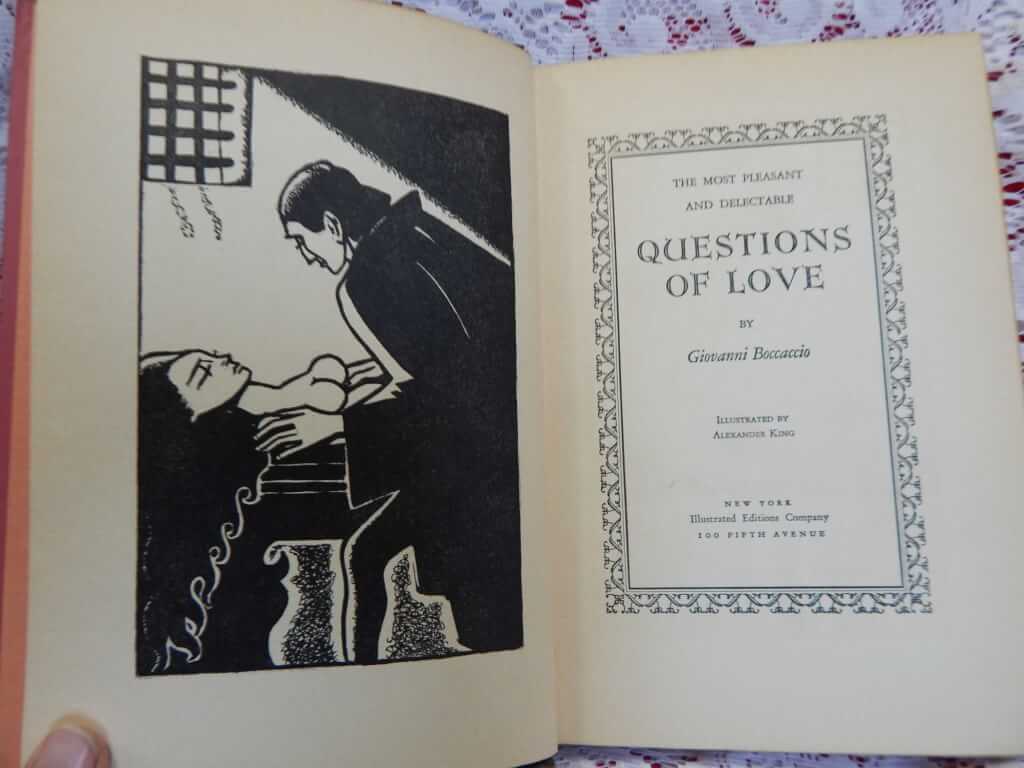 The Most Pleasant and Delectable Questions of Love, by Giovanni Boccaccio, illus. by Alexander King (Illustrated Editions Company, New York, 1931) 6.5"x9.5", 133pp, red and black boards, binding good, some yellowing to pages. "The translation of 1566 [the fourth part of Filocolo] by H. G. Put into modern English with an introduction by Thomas Bell." This book is 13 chapters of one of Boccaccio's longer works, "Il libro di Difinizioni", first translated into English by "H.G." (probably Henry Grantham) in London, 1566. In these chapters, a group of young people have gone to the country for the day. One of the young women is chosen "The Queen of Love." Each young person tells a love story and poses a question about love. The group answers; there is no right or wrong. But the final arbiter, "The Queen of Love," holds the answers. Giovanni Boccaccio (1313-1375) was an Italian author and poet, a friend, student, and correspondent of Petrarch, an important Renaissance humanist and the author of a number of notable works including the Decameron, On Famous Women, and his poetry in the Italian vernacular. Boccaccio is particularly notable for his dialogue, of which it has been said that it surpasses in verisimilitude that of virtually all of his contemporaries, since they were medieval writers and often followed formulaic models for character and plot. Alexander King (1899–1965), born Alexander Koenig in Vienna, was a bestselling humorist, memoirist and media personality of the early television era, based in the United States. In his late fifties, after becoming a frequent guest on the a Tonight Show hosted by Jack Paar, King emerged as an incongruous presence in the realm of national celebrity: an aging, irascible raconteur, with elegant mannerisms and trademark bow-tie, who spoke frankly and disarmingly about his bohemian lifestyle, multiple marriages, and years-long struggle with drug addiction. His checkered past led TIME magazine to describe him as "an ex-illustrator, ex-cartoonist, ex-adman, ex-editor, ex-playwright, ex-dope addict. For a quarter-century he was an ex-painter, and by his own bizarre account qualifies as an ex-midwife. He is also an ex-husband to three wives and an ex-Viennese of sufficient age (60) to remember muttonchopped Emperor Franz Joseph. When doctors told him a few years ago that he might soon be an ex-patient (two strokes, serious kidney disease, peptic ulcer, high blood pressure), he sat down to tell gay stories of the life of all these earlier Kings."
The Most Pleasant and Delectable Questions of Love, by Giovanni Boccaccio, illus. by Alexander King (Illustrated Editions Company, New York, 1931) 6.5"x9.5", 133pp, red and black boards, binding good, some yellowing to pages. "The translation of 1566 [the fourth part of Filocolo] by H. G. Put into modern English with an introduction by Thomas Bell." This book is 13 chapters of one of Boccaccio's longer works, "Il libro di Difinizioni", first translated into English by "H.G." (probably Henry Grantham) in London, 1566. In these chapters, a group of young people have gone to the country for the day. One of the young women is chosen "The Queen of Love." Each young person tells a love story and poses a question about love. The group answers; there is no right or wrong. But the final arbiter, "The Queen of Love," holds the answers. Giovanni Boccaccio (1313-1375) was an Italian author and poet, a friend, student, and correspondent of Petrarch, an important Renaissance humanist and the author of a number of notable works including the Decameron, On Famous Women, and his poetry in the Italian vernacular. Boccaccio is particularly notable for his dialogue, of which it has been said that it surpasses in verisimilitude that of virtually all of his contemporaries, since they were medieval writers and often followed formulaic models for character and plot. Alexander King (1899–1965), born Alexander Koenig in Vienna, was a bestselling humorist, memoirist and media personality of the early television era, based in the United States. In his late fifties, after becoming a frequent guest on the a Tonight Show hosted by Jack Paar, King emerged as an incongruous presence in the realm of national celebrity: an aging, irascible raconteur, with elegant mannerisms and trademark bow-tie, who spoke frankly and disarmingly about his bohemian lifestyle, multiple marriages, and years-long struggle with drug addiction. His checkered past led TIME magazine to describe him as "an ex-illustrator, ex-cartoonist, ex-adman, ex-editor, ex-playwright, ex-dope addict. For a quarter-century he was an ex-painter, and by his own bizarre account qualifies as an ex-midwife. He is also an ex-husband to three wives and an ex-Viennese of sufficient age (60) to remember muttonchopped Emperor Franz Joseph. When doctors told him a few years ago that he might soon be an ex-patient (two strokes, serious kidney disease, peptic ulcer, high blood pressure), he sat down to tell gay stories of the life of all these earlier Kings." -
Out of stock

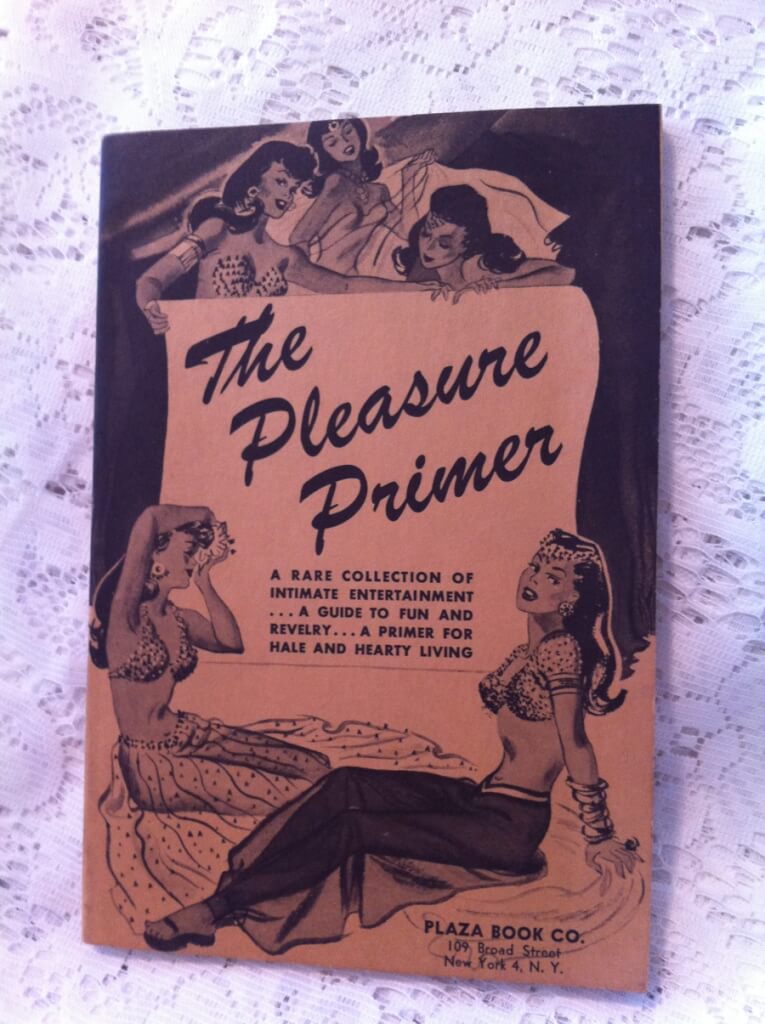 The Pleasure Primer, a rare collection of intimate entertainment...a guide to fun and revelry...a primer for hale and hearty living, Ed. Walter S. Keating, Illus. Alton Pickens (Plaza Book Company, New York, 1943) 8" x 5.5", 128pp., soft covers, near fine condition. From the ad: "No woman is safe (or really wants to be) when a man’s mind is in the bedroom. See the tempting, puffed-up featherbed to be despoiled! Hear the irrepressible squeals of pleasure! Those to whom bedtime has come to mean “bed and bored” will find “bed and better” . . . Thousands are now enjoying Rollicking Bedside Fun, and you will too, when you possess this ideal bedside companion. Here’s entertainment for open minds and ticklish spines. Here’s lusty, merry recreation for un-squeamish men and women. Here’s life with apologies to none. Collected, selected from the best there is, this zestful Primer is an eye-opener … YOU ARE INVITED TO EXAMINE THE PLEASURE PRIMER 10 DAYS AT OUR EXPENSE. IT IS GUARANTEED TO PLEASE OR YOUR PURCHASE PRICE WILL BE REFUNDED AT ONCE!" This is a collection of articles and reprints of stories by noted authors throughout history from Boccaccio to Twain.
The Pleasure Primer, a rare collection of intimate entertainment...a guide to fun and revelry...a primer for hale and hearty living, Ed. Walter S. Keating, Illus. Alton Pickens (Plaza Book Company, New York, 1943) 8" x 5.5", 128pp., soft covers, near fine condition. From the ad: "No woman is safe (or really wants to be) when a man’s mind is in the bedroom. See the tempting, puffed-up featherbed to be despoiled! Hear the irrepressible squeals of pleasure! Those to whom bedtime has come to mean “bed and bored” will find “bed and better” . . . Thousands are now enjoying Rollicking Bedside Fun, and you will too, when you possess this ideal bedside companion. Here’s entertainment for open minds and ticklish spines. Here’s lusty, merry recreation for un-squeamish men and women. Here’s life with apologies to none. Collected, selected from the best there is, this zestful Primer is an eye-opener … YOU ARE INVITED TO EXAMINE THE PLEASURE PRIMER 10 DAYS AT OUR EXPENSE. IT IS GUARANTEED TO PLEASE OR YOUR PURCHASE PRICE WILL BE REFUNDED AT ONCE!" This is a collection of articles and reprints of stories by noted authors throughout history from Boccaccio to Twain. -
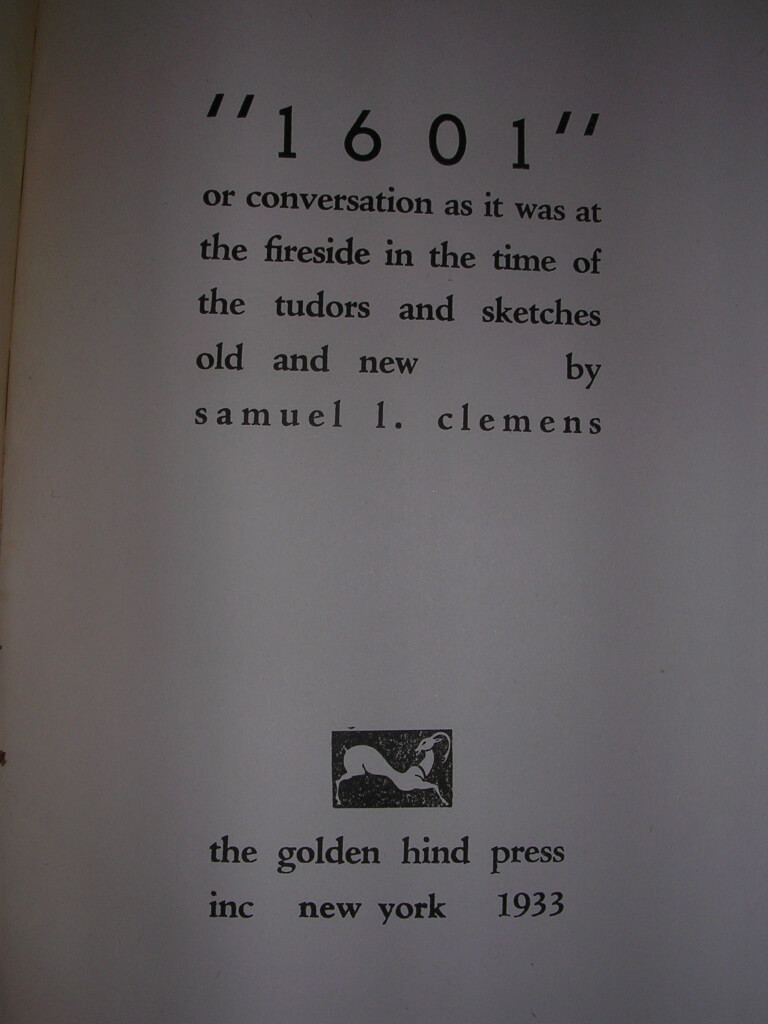
 "1601" or conversation as it was at the fireside in the time of the tudors and sketches old and new by Samuel L. Clemens, Mark Twain, Preface by Samuel Roth (The Golden Hind Press Inc., New York, 1933) 9 1/8" X 6 1/8", 204pp, hardbound no DJ, red cloth boards with gilt decorations and title, fair condition, boards detaching, binding intact, fading on boards and spine [Date: 1601.] Conversation, as it was the Social Fireside, in the Time of the Tudors is the title of a humorous work by Mark Twain, first published anonymously in 1880. Edward Wagenknecht once referred to it as "the most famous piece of pornography in American literature." Its content is irreverent and vulgar rather than obscene, and its purpose seems to be comedic shock rather than erotic arousal. It would thus qualify as ribaldry rather than pornography. Twain wrote 1601 during the summer of 1876 (between writing Tom Sawyer and Huckleberry Finn), for the amusement of his closest friend, Reverend Joseph Twichell, 1601 was later first published by another friend, John Hay, who later became Secretary of State. The work circulated among printers (due to it's often archaic type font) and many small batches were printed, however the authorship of the work remained unverified until Twain finally acknowledged he wrote it in 1906. This book contains 1601 and numerous sketches previously published as "Sketches Old and New"
"1601" or conversation as it was at the fireside in the time of the tudors and sketches old and new by Samuel L. Clemens, Mark Twain, Preface by Samuel Roth (The Golden Hind Press Inc., New York, 1933) 9 1/8" X 6 1/8", 204pp, hardbound no DJ, red cloth boards with gilt decorations and title, fair condition, boards detaching, binding intact, fading on boards and spine [Date: 1601.] Conversation, as it was the Social Fireside, in the Time of the Tudors is the title of a humorous work by Mark Twain, first published anonymously in 1880. Edward Wagenknecht once referred to it as "the most famous piece of pornography in American literature." Its content is irreverent and vulgar rather than obscene, and its purpose seems to be comedic shock rather than erotic arousal. It would thus qualify as ribaldry rather than pornography. Twain wrote 1601 during the summer of 1876 (between writing Tom Sawyer and Huckleberry Finn), for the amusement of his closest friend, Reverend Joseph Twichell, 1601 was later first published by another friend, John Hay, who later became Secretary of State. The work circulated among printers (due to it's often archaic type font) and many small batches were printed, however the authorship of the work remained unverified until Twain finally acknowledged he wrote it in 1906. This book contains 1601 and numerous sketches previously published as "Sketches Old and New" -
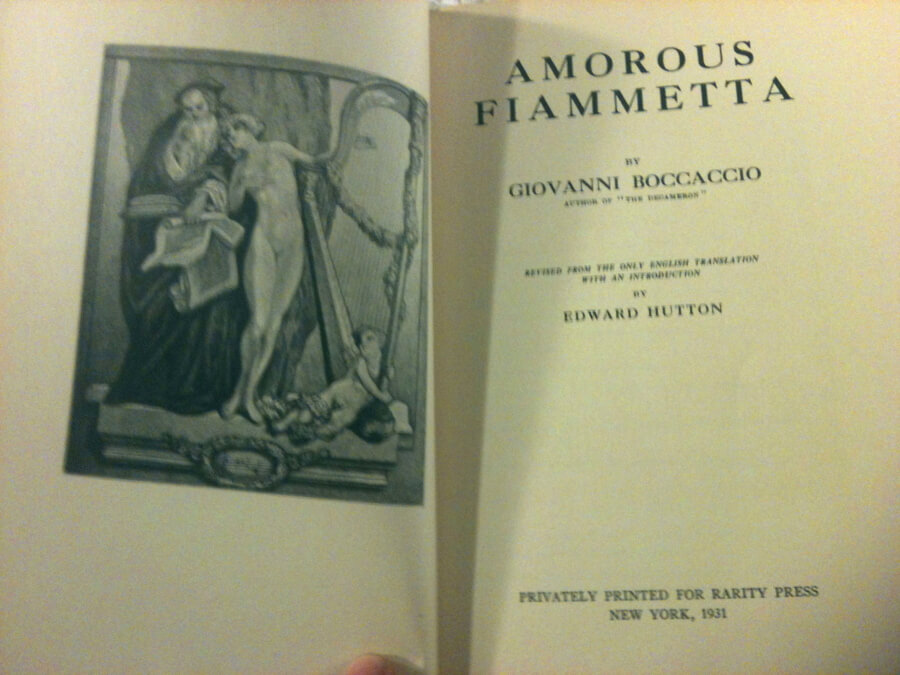
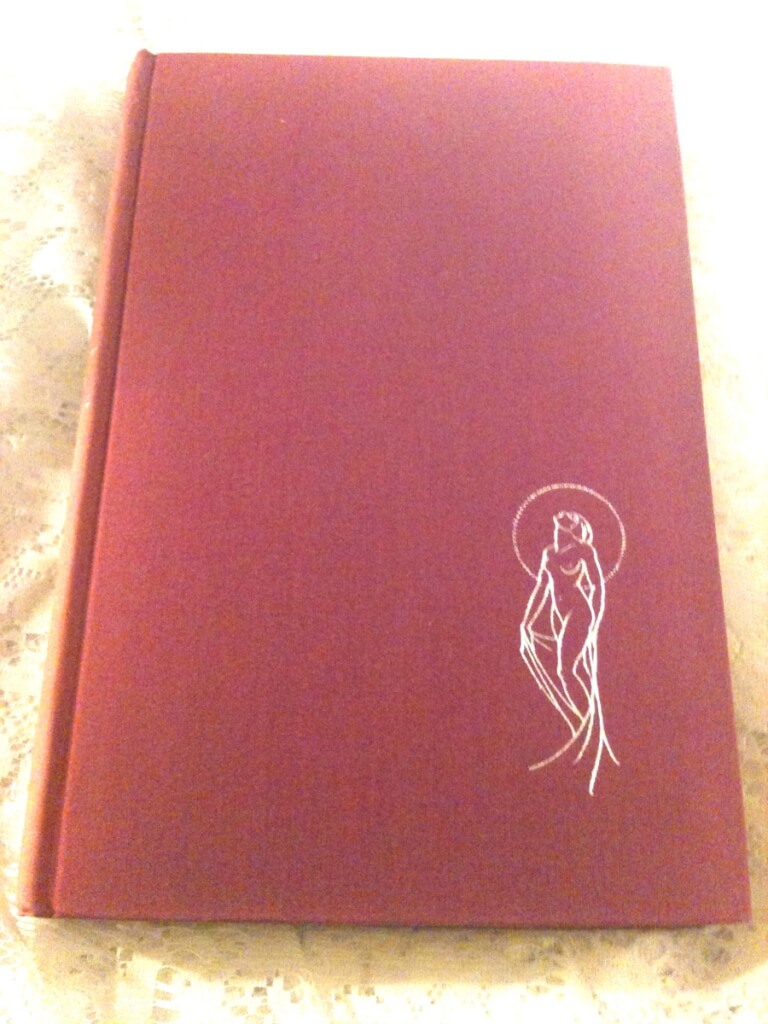 Amorous Fiammetta, Giovanni Boccaccio, introduction by Edward Hutton, trans. & illus. various unknown. (Rarity Press, New York, 1931 ) 9.5" X 6.5", 356pp, Hardcover no DJ, red cloth boards, botton and fore edges deckled. Good condition for age, a fading on spine, silver gilt lettering and decorations Originally titled "Elegia di Madonna Fiammetta" (The Elegy of Lady Fiammetta), this marvelous European romance was written by Giovanni Boccaccio somewhere between 1343 and 1344. It is a first-person confessional monologue narrated by a woman and is considered the first psychological novel in a modern language and a precursor of stream-of-consciousness fiction. Lady Fiammetta, recounts how, although a married woman, she falls in love with a handsome young foreigner named Panfilo and, becomes his lover. Panfilo subsequently abandons Fiammetta and returns to his native land, where his father is said to be dying. When he fails to keep his promise to return, Fiammetta, describes her longings, her anguish, and her despair. A host of contradictory sentiments drive her to desperation and to an unsuccessful suicide attempt. After a time, Fiammetta resumes her futile wait for Panfilo. She finally resolves to seek him out in his native land. Disguising her true intent from her husband, she secures his promise to help her in this undertaking. Addressing an exclusively female audience, Fiammetta warns them about the vicious ways of men. Her whole narrative adds up to an indictment of men as both readers and lovers. Fiammetta has been variously described as a pathetic victim of male cruelty; an irresponsible fool of a girl; a sophisticated, cunning, and wholly disingenuous female; and, finally, a genuinely modern woman. Whatever judgment we make of her, Fiammetta stands out among medieval women as an ardent and outspoken feminist. Sometime around 1330 Boccaccio fell in love and married his "Fiammetta" who most believe is Maria d'Aquino (?-1382), a royal bastard, an illegitimate daughter of Robert the Wise, King of Naples and Count of Provence. He wrote about her and their relationship in several of his literary works. She is traditionally identified as Fiammetta. According to him, Maria's mother was a Provençal noblewoman, Sibila Sabran, wife of Count Thomas IV of Aquino. She was born after Countess Sibila and King Robert committed adultery at his coronation festivities in 1310, but was given the family name of her mother's husband. Her putative father placed her in a convent. In 1345 she was an accomplice in the murder of King Andrew, the husband of her niece and Robert's successor, Queen Joanna I. For this Maria was sentenced to death and beheaded in 1382 on the orders of Queen Joanna I's successor, King Charles III.
Amorous Fiammetta, Giovanni Boccaccio, introduction by Edward Hutton, trans. & illus. various unknown. (Rarity Press, New York, 1931 ) 9.5" X 6.5", 356pp, Hardcover no DJ, red cloth boards, botton and fore edges deckled. Good condition for age, a fading on spine, silver gilt lettering and decorations Originally titled "Elegia di Madonna Fiammetta" (The Elegy of Lady Fiammetta), this marvelous European romance was written by Giovanni Boccaccio somewhere between 1343 and 1344. It is a first-person confessional monologue narrated by a woman and is considered the first psychological novel in a modern language and a precursor of stream-of-consciousness fiction. Lady Fiammetta, recounts how, although a married woman, she falls in love with a handsome young foreigner named Panfilo and, becomes his lover. Panfilo subsequently abandons Fiammetta and returns to his native land, where his father is said to be dying. When he fails to keep his promise to return, Fiammetta, describes her longings, her anguish, and her despair. A host of contradictory sentiments drive her to desperation and to an unsuccessful suicide attempt. After a time, Fiammetta resumes her futile wait for Panfilo. She finally resolves to seek him out in his native land. Disguising her true intent from her husband, she secures his promise to help her in this undertaking. Addressing an exclusively female audience, Fiammetta warns them about the vicious ways of men. Her whole narrative adds up to an indictment of men as both readers and lovers. Fiammetta has been variously described as a pathetic victim of male cruelty; an irresponsible fool of a girl; a sophisticated, cunning, and wholly disingenuous female; and, finally, a genuinely modern woman. Whatever judgment we make of her, Fiammetta stands out among medieval women as an ardent and outspoken feminist. Sometime around 1330 Boccaccio fell in love and married his "Fiammetta" who most believe is Maria d'Aquino (?-1382), a royal bastard, an illegitimate daughter of Robert the Wise, King of Naples and Count of Provence. He wrote about her and their relationship in several of his literary works. She is traditionally identified as Fiammetta. According to him, Maria's mother was a Provençal noblewoman, Sibila Sabran, wife of Count Thomas IV of Aquino. She was born after Countess Sibila and King Robert committed adultery at his coronation festivities in 1310, but was given the family name of her mother's husband. Her putative father placed her in a convent. In 1345 she was an accomplice in the murder of King Andrew, the husband of her niece and Robert's successor, Queen Joanna I. For this Maria was sentenced to death and beheaded in 1382 on the orders of Queen Joanna I's successor, King Charles III.
